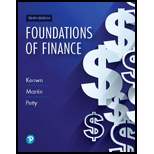
Foundations Of Finance
10th Edition
ISBN: 9780134897264
Author: KEOWN, Arthur J., Martin, John D., PETTY, J. William
Publisher: Pearson,
expand_more
expand_more
format_list_bulleted
Textbook Question
Chapter 7, Problem 9SP
(
- a. Compute the bond’s expected rate of return.
- b. Determine the value of the bond to you given your required rate of return.
- c. Should you purchase the bond?
Expert Solution & Answer
Want to see the full answer?
Check out a sample textbook solution
Students have asked these similar questions
What is a dividend and how does it benefit investors?
What is a dividend and how does it benefit investors?need help!
How does inflation impact investment returns in finance?
i need answer!
Chapter 7 Solutions
Foundations Of Finance
Ch. 7 - Prob. 1RQCh. 7 - Prob. 2RQCh. 7 - Prob. 3RQCh. 7 - a. How does a bonds par value differ from its...Ch. 7 - Prob. 5RQCh. 7 - Prob. 6RQCh. 7 - Prob. 7RQCh. 7 - Prob. 8RQCh. 7 - Prob. 9RQCh. 7 - Define the expected rate of return to bondholders.
Ch. 7 - (Bond valuation) Bellingham bonds have an annual...Ch. 7 - (Bond valuation) Flora Co.s bonds, maturing in 7...Ch. 7 - (Bond valuation) You own a 20-year, 1,000 par...Ch. 7 - (Bond valuation) Calculate the value of a bond...Ch. 7 - (Bond valuation) At the beginning of the year, you...Ch. 7 - Prob. 6SPCh. 7 - (Bond relationship) Mason, Inc. has two bond...Ch. 7 - Prob. 8SPCh. 7 - (Bond valuation) National Steels 15-year, 1,000...Ch. 7 - (Bond valuation) You own a bond that pays 70 in...Ch. 7 - Prob. 11SPCh. 7 - (Bond valuationzero coupon) The Latham Corporation...Ch. 7 - (Bond valuation) Bank of America has bonds that...Ch. 7 - Prob. 15SPCh. 7 - Prob. 16SPCh. 7 - Prob. 17SPCh. 7 - (Bondholders expected rate of return) You own a...Ch. 7 - (Expected rate of return and current yield) Time...Ch. 7 - (Expected rate of return and current yield)...Ch. 7 - Prob. 21SPCh. 7 - Prob. 22SPCh. 7 - (Current yield) Assume you have a bond with a...Ch. 7 - Prob. 24SPCh. 7 - (Expected rate of return) Assume you own a bond...Ch. 7 - Prob. 26SPCh. 7 - (Bondholders expected rate of return) You...Ch. 7 - Prob. 1MCCh. 7 - Assume that the bonds are selling for the...Ch. 7 - Prob. 3MCCh. 7 - Prob. 4MCCh. 7 - Prob. 5MC
Knowledge Booster
Learn more about
Need a deep-dive on the concept behind this application? Look no further. Learn more about this topic, finance and related others by exploring similar questions and additional content below.Similar questions
- Nonearrow_forwardWhat is the marketing communication budget plan for this types of campaign (not specific, can be general amount in peso): • Television Commercial • Radio • In-store/banner/billboards • Publication Materials for Facebook and Instagram • Reels/TikTok Videos • GIF • Marathon • Campus Caravan • E-Vouchers • Deals Offer Considering a 60 million pesos budget for one year. Please cite references.arrow_forwardWhat is the amount of budget that could be provided using these advertisements? (not specific, can be general amount in peso): • Television Commercial • Radio • In-store/banner/billboards • Publication Materials for Facebook and Instagram • Reels/TikTok Videos • GIF • Marathon • Campus Caravan • E-Vouchers • Deals Offer Please cite references.arrow_forward
arrow_back_ios
SEE MORE QUESTIONS
arrow_forward_ios
Recommended textbooks for you
 EBK CONTEMPORARY FINANCIAL MANAGEMENTFinanceISBN:9781337514835Author:MOYERPublisher:CENGAGE LEARNING - CONSIGNMENTPrinciples of Accounting Volume 1AccountingISBN:9781947172685Author:OpenStaxPublisher:OpenStax College
EBK CONTEMPORARY FINANCIAL MANAGEMENTFinanceISBN:9781337514835Author:MOYERPublisher:CENGAGE LEARNING - CONSIGNMENTPrinciples of Accounting Volume 1AccountingISBN:9781947172685Author:OpenStaxPublisher:OpenStax College

EBK CONTEMPORARY FINANCIAL MANAGEMENT
Finance
ISBN:9781337514835
Author:MOYER
Publisher:CENGAGE LEARNING - CONSIGNMENT

Principles of Accounting Volume 1
Accounting
ISBN:9781947172685
Author:OpenStax
Publisher:OpenStax College
What happens to my bond when interest rates rise?; Author: The Financial Pipeline;https://www.youtube.com/watch?v=6uaXlI4CLOs;License: Standard Youtube License